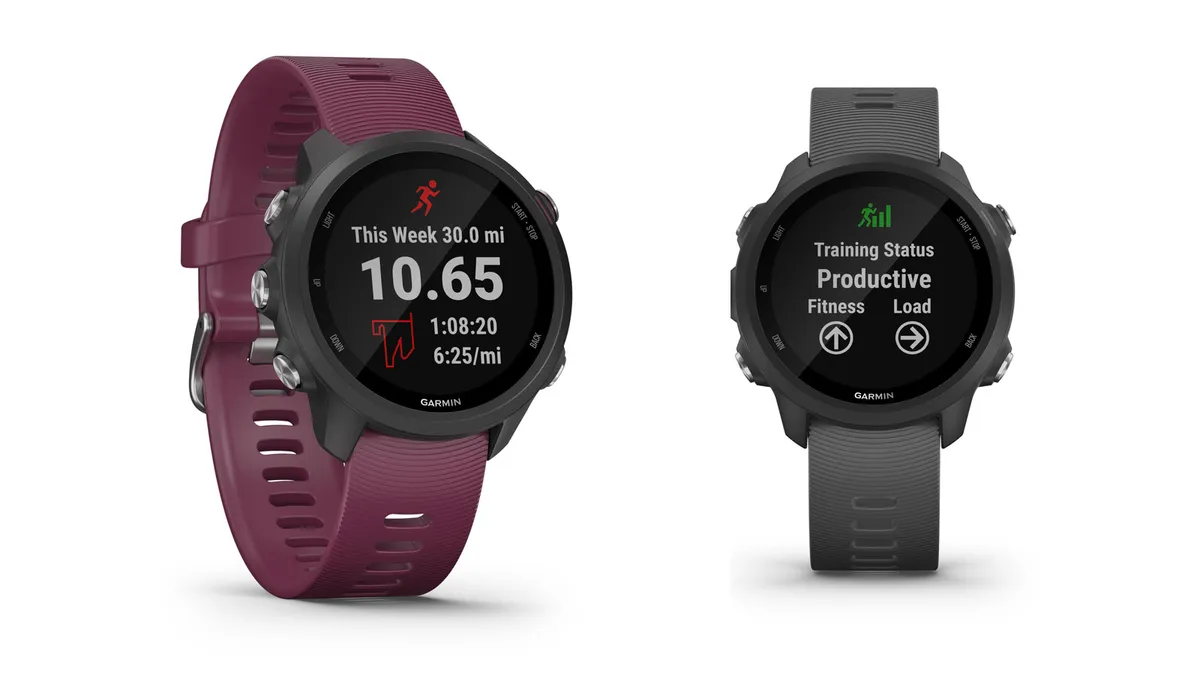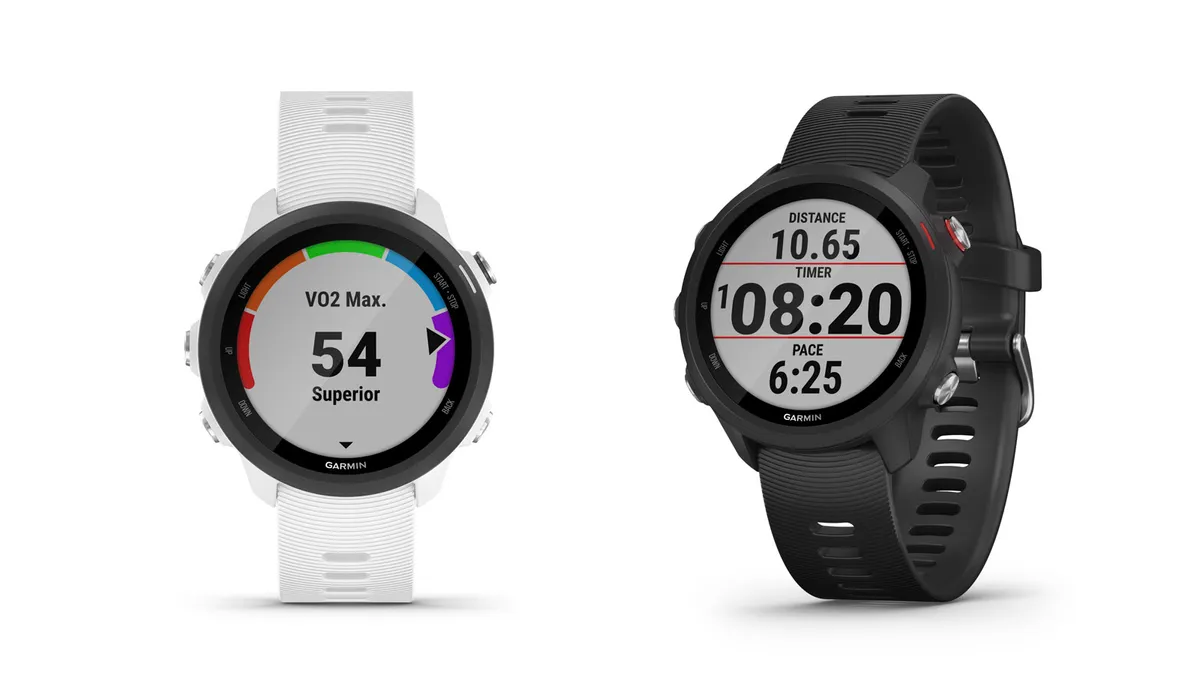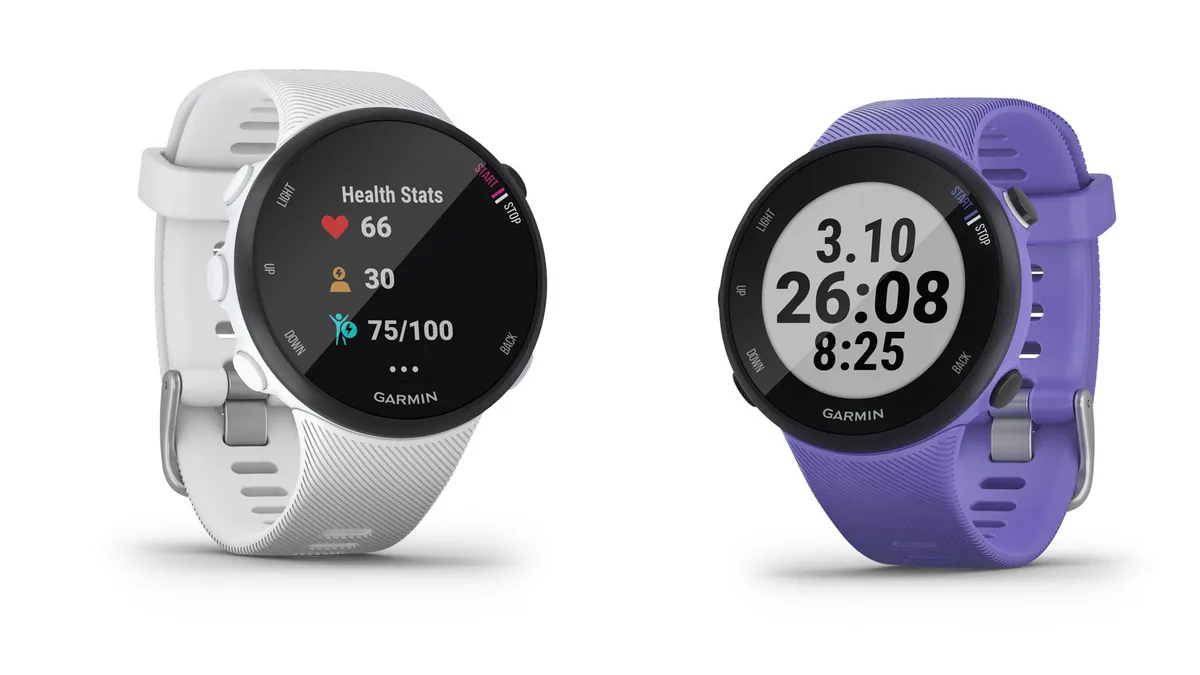On the back of the new Edge 530 and 830 computers, Garmin has just announced five new GPS smartwatches — the Forerunner 945, the Forerunners 245 and 245 Music, and the Forerunners 45 and 45S.
- Best GPS and smartwatches for cycling: how to choose the right one for you
- Best bike computer for 2019 | GPS devices for riding, training, touring and navigation
The new watches stick with the five-button design, rather than a touchscreen, and include an always-on sunlight-readable, memory-in-pixel colour display.
As you’d expect, the new Forerunners have built-in optical heart rate, as well as step, calorie and sleep cycle tracking. However, Garmin has added new safety and tracking features that allow you to share your real-time location with predetermined contacts, and call for help if you need it.
The watches also give you access to Garmin Coach, which allows for professionally designed workouts and training plans to be synced to the watch from Garmin Connect, and will scale based on your current fitness. You can upload your own workouts to the watch too, as with the earlier versions.
At the moment, Garmin Coach only extends to running workouts, but, we guess that cycling plans won’t be too far off.
Garmin Forerunner 945

Pitched as a premium multisport watch, the Garmin Forerunner 945 replaces the 935, and features built-in GPS, GLONASS and Galileo connectivity for ultimate accuracy.
Beyond the optical heart rate, the watch gets the new Pulse OX sensor, which is claimed to monitor blood-oxygen saturation, altitude acclimation and advance sleep monitoring metrics too.
With a Corning Gorilla Glass DX lens, the watch measures 47 x 47 x 13.7mm and has a display resolution of 240 x 240 pixels.
Claimed to weigh 50g, the bezel is made from fibre-reinforced polymer, and is compatible with Garmin QuickFit watch bands, and plays nice with the Varia Lights.
Beyond the positioning chip, the Forerunner 945 sees a barometric altimeter, compass, gyroscope accelerometer, and can communicate with devices and sensors via Bluetooth, ANT+ and WiFi — including power meters.
Battery life is claimed to be up to two weeks in smartwatch mode, up to 36 hours in GPS mode and up to 10 hours in GPS mode with music.
The 945 also gets the FirstBeat calculations to analyse your recent activities and let you know if your training has been productive, while highlighting areas you might need to work on.
Interestingly, in the specs, Garmin shows the new ClimbPro Ascent planner as featured on the new Edge computers under ‘Outdoor Recreation Features,’ but on the profiles it's available to, cycling is not listed.
The watch gets built-in full-colour base maps, and sees the brand's Trendline routing, which uses Garmin Connect data to route you down popular roads and trails.
The new 945 also features Garmin Pay and can store up to 1,000 songs from synced playlists, including those from Spotify or Deezer.
Available in May, the Forerunner 945 will cost £520 / $600 / AU$950 for the watch alone.
Garmin Forerunner 245 and 245 Music

Slotting a few spaces down in the Forerunner hierarchy are the 245 and 245 Music. These watches maintain connectivity to the GPS, GLONASS and Galileo networks, built-in optical heart rate and Pulse OX sensors, and Bluetooth, ANT+ and WiFi Connectivity, but lack some of the sensors and functionality of the 945.
With a slightly smaller form factor, the 245 still sees a Corning Gorilla Glass 3 lens, measures 42.3 x 42.3 x 12.2 mm, has a fibre-reinforced bezel, 240 x 240 pixels display and is a claimed weight of 38.5g.
The battery life is slightly reduced and claims up to 7 days in smartwatch mode, up to 6 hours in GPS mode with music and up 24 hours GPS mode without music.
The 245 only gets a built-in compass and accelerometer, so altitude measurement will be gleaned from GPS, which are often inaccurate. The watch also lacks support for power meters and misses out on ClimbPro too.
Even still, the lower end watch does feature the FirstBeat training software, support for the Varia lights, breadcrumb-style navigation and the ability to sync workouts through Garmin Coach.
The Forerunner 245 starts at £250 / $300 / AU$500 and costs an extra fifty bucks for the music version.
Garmin Forerunner 45 and 45S

At £170 / $200 / AU$300 the Forerunner 4 and 4S might be the most budget-friendly and basic watches in the range, but they are still more capable than what we would class as a ‘fitness tracker’, such as the Vivoactive watches.
These cheaper Forerunners have all the basic features of their more expensive counterparts including GPS, GLONASS and Galileo positioning, ANT+ connectivity, and built-in optical heart rate and an accelerometer.
The ‘S’ version is designed for smaller wrists measuring 39.5 x 39.5 x 11.4 mm (with case), while the standard version is 42 x 42 x 11.4 mm. Both share a 208 x 208px screen and have a claimed battery life of up to 7 days in Smartwatch mode and 13 hours with GPS tracking.
Being where it is in the range, sensor support is limited, and only basic cycling metrics are available, but the watch does have a cycling-specific profile with the ability to add indoor cycling through Garmin Connect.
The specs mention iPhone and Android compatibility, however, the same spec sheet doesn't mention a Bluetooth connection.